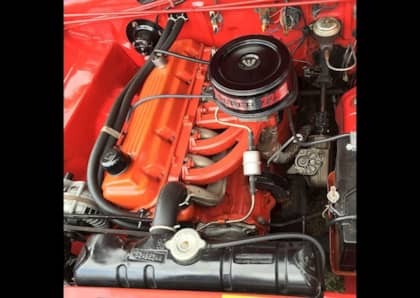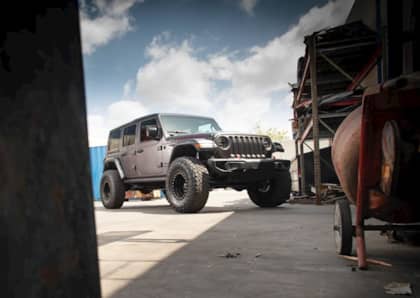The 5 Best Jeep Engines Of All-Time
Jeep has an unusual history when it comes to engines. The brand's ownership has changed hands more times than a Honus Wagner baseball card, and in the process it's been subjected to the whims and best laid plans of companies that didn't always have the firmest financial footing or engineering resources.

Which are the more compelling Jeep power plants to have emerged from this hodge-podge of mixed mechanical DNA? Here are our picks for the best Jeep engines of all-time.
Willys Go Devil
The original Willys Jeep was built for the American armed forces as a go-anywhere runabout that saw action in World War II. The Civilian Jeep, or 'CJ,' helped popularize off-roading as a post-war pastime, and a big part of that vehicle's appeal was its battle-tested engine, the four-cylinder Go Devil.

Evolving over a five year period from a low-powered, economy-focused motor to an ultra-reliable, torque-happy military-spec motor, the Go Devil produced around 60 hp and 105 lb-ft of twist from its 134 cubic inches of displacement. The Go Devil transitioned almost seamlessly to civilian life, where it gained an improved cooling system and a smoother crankshaft to help it better fit in on rural roads.

The engine remained in production until 1952, when the Willys Hurricane took over—no, not the twin-turbo inline-six that's on its way under the hood of the new Jeep Grand Wagoneer, but the original four- and six-cylinder flatheads, which provided a substantial power boost over the original Go Devil design thanks to their improved breathing and higher compression ratio.
401 V8
The biggest V8 ever outfitted to any Jeep model was the AMC 401. The ultimate edition of the American Motors eight-cylinder architecture, the 401 was offered in a number of different guises (including the Javelin muscle car) alongside its use in the full-size Jeep (Wagoneer, Cherokee, and J-Series pickups).

The 401 cubic inch engine represented the third generation V8 built by AMC, evolving from the 390 CID that had never made it into a Jeep, and featuring forged rods and a forged crankshaft. Power ranged from 330 horses to sub-200 ponies by the end if the 1970s after emissions equipment had choked the motor down from its glory days. Torque peaked at just over 400 lb-ft. Like most large-displacement motors of the era, the 401 ended its days under the hood of Jeep's largest SUVs, as rising fuel costs had pushed it fully out of the passenger car mix by 1977.
4.0L I6
Of all the Jeep engines in all the world, the 4.0L inline six-cylinder is by far the most famous. One of the final motors to have been developed by AMC, it debuted in 1986 as the mightiest option available from the XJ-generation Cherokee, and it remained in the Jeep line-up through not one, not two, but three changes in corporate ownership over the next 20 years of Jeep's history.

What about the Jeep 4.0 has made it so popular with owners and enthusiasts alike?
In a word: reliability. The 4.0 I6 has a reputation as an unkillable engine, a motor that can take huge amounts of abuse (and mileage) and keep on ticking. By the early 1990s, the motor was good for a respectable 190 hp (in High Output trim), and it had spread across the line-up to be available in the larger Grand Cherokee, the Comanche pickup, and the iconic Wrangler.
3.6L Pentastar V6
After the disappearance of the 4.0, Jeep's six-cylinder fortunes floundered for a few years as parent company Chrysler attempted to stop the gap with the workman-like, but ultimately uninspiring V6 originally offered with the brand's minivan line-up. In 2012, however, a new bright spot appeared on the horizon in the form of the Chrysler 3.6L Pentastar V6.

Let's be clear: the Pentastar is not an 'exciting' engine. That being said, with 285 hp and 260 lb-ft of torque on tap it presented a huge upgrade over the motor it replaced, with a fuel mileage bonus to match. One of the final pieces of the modernization puzzle that the JK-generation Wrangler had been trying to put together, the Pentastar was also offered as the entry-level motor for the Grand Cherokee (with a smaller displacement edition found in the compact Cherokee).
3.0L Turbodiesel V6
Jeep was one of the first domestic SUV builders to turn to diesel, starting with a common rail motor in the late-2000s. By the middle of the following decade it had significantly improved its turbodiesel offerings thanks to Fiat-Chrysler's ties to Italian engine builder VM Motori.

The result was the 3.0L 'EcoDiesel,' a motor that could be had with the Grand Cherokee (and much later the Wrangler and the Gladiator). Featuring 240 hp and 420 lb-ft of torque, the turbodiesel unit was capable of 30 highway miles per gallon, which represented a big step up in efficiency for Jeep's larger options with no real significant reduction in performance. No other similarly-sized American sport-utility vehicle has been able to match that level of frugality and muscle.











